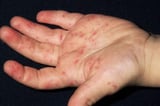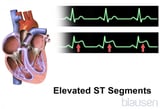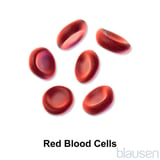Can a Blood Clot Stop Hurting and Start Again
Hemostasis is the trunk'due south fashion of stopping injured blood vessels from bleeding. Hemostasis includes clotting of the blood.
-
Too lilliputian clotting can cause excessive bleeding from minor injury
-
Besides much clotting can block blood vessels that are non bleeding
Consequently, the body has command mechanisms to limit clotting and dissolve clots that are no longer needed. An abnormality in whatsoever part of the organization that controls haemorrhage can atomic number 82 to excessive bleeding Bruising and Bleeding Bruising or bleeding later on an injury is normal (see also How Claret Clots). However, some people accept disorders that cause them to trample or bleed too easily. Sometimes people drain without any... read more  or excessive clotting Excessive Clotting Excessive clotting (thrombophilia) occurs when the blood clots too easily or excessively. Inherited and caused disorders can increase blood clotting. Clots crusade legs or arms to swell. Blood... read more , both of which tin can be unsafe. When clotting is poor, even a slight injury to a blood vessel may lead to severe blood loss. When clotting is excessive, modest blood vessels in disquisitional places can go clogged with clots. Chock-full vessels in the brain tin can cause strokes Overview of Stroke A stroke occurs when an artery to the brain becomes blocked or ruptures, resulting in death of an expanse of brain tissue due to loss of its blood supply (cognitive infarction) and symptoms that... read more , and clogged vessels leading to the center tin can cause eye attacks Acute Coronary Syndromes (Heart Attack; Myocardial Infarction; Unstable Angina) Acute coronary syndromes effect from a sudden blockage in a coronary artery. This blockage causes unstable angina or heart assault (myocardial infarction), depending on the location and corporeality... read more
or excessive clotting Excessive Clotting Excessive clotting (thrombophilia) occurs when the blood clots too easily or excessively. Inherited and caused disorders can increase blood clotting. Clots crusade legs or arms to swell. Blood... read more , both of which tin can be unsafe. When clotting is poor, even a slight injury to a blood vessel may lead to severe blood loss. When clotting is excessive, modest blood vessels in disquisitional places can go clogged with clots. Chock-full vessels in the brain tin can cause strokes Overview of Stroke A stroke occurs when an artery to the brain becomes blocked or ruptures, resulting in death of an expanse of brain tissue due to loss of its blood supply (cognitive infarction) and symptoms that... read more , and clogged vessels leading to the center tin can cause eye attacks Acute Coronary Syndromes (Heart Attack; Myocardial Infarction; Unstable Angina) Acute coronary syndromes effect from a sudden blockage in a coronary artery. This blockage causes unstable angina or heart assault (myocardial infarction), depending on the location and corporeality... read more  . Pieces of clots from veins in the legs, pelvis, or abdomen can travel through the bloodstream to the lungs and block major arteries there (pulmonary embolism Pulmonary Embolism (PE) Pulmonary embolism is the blocking of an avenue of the lung (pulmonary artery) by a collection of solid material brought through the bloodstream (embolus)—ordinarily a blood jell (thrombus) or... read more ).
. Pieces of clots from veins in the legs, pelvis, or abdomen can travel through the bloodstream to the lungs and block major arteries there (pulmonary embolism Pulmonary Embolism (PE) Pulmonary embolism is the blocking of an avenue of the lung (pulmonary artery) by a collection of solid material brought through the bloodstream (embolus)—ordinarily a blood jell (thrombus) or... read more ).
Hemostasis involves three major processes:
-
Narrowing (constriction) of blood vessels
-
Activity of proteins plant in blood that work with platelets to assistance the claret clot (clotting factors)
Blood Clots: Plugging the Breaks
When an injury causes a blood vessel wall to break, platelets are activated. They change shape from round to spiny, stick to the broken vessel wall and each other, and begin to plug the break. They as well interact with other claret proteins to course fibrin. Fibrin strands form a internet that entraps more than platelets and blood cells, producing a clot that plugs the break.
An injured blood vessel constricts so that claret flows out more slowly and clotting tin first. At the same time, the accumulating pool of blood outside the claret vessel (a hematoma) presses against the vessel, helping forbid farther haemorrhage.
Equally soon equally a claret vessel wall is damaged, a series of reactions activates platelets Platelets The main components of blood include Plasma Red claret cells White blood cells Platelets read more  so that they stick to the injured area. The "glue" that holds platelets to the blood vessel wall is von Willebrand gene, a big protein produced by the cells of the vessel wall. The proteins collagen and thrombin act at the site of the injury to induce platelets to stick together. Every bit platelets accumulate at the site, they form a mesh that plugs the injury. The platelets alter shape from circular to spiny, and they release proteins and other substances that entrap more platelets and clotting proteins in the enlarging plug that becomes a blood jell.
so that they stick to the injured area. The "glue" that holds platelets to the blood vessel wall is von Willebrand gene, a big protein produced by the cells of the vessel wall. The proteins collagen and thrombin act at the site of the injury to induce platelets to stick together. Every bit platelets accumulate at the site, they form a mesh that plugs the injury. The platelets alter shape from circular to spiny, and they release proteins and other substances that entrap more platelets and clotting proteins in the enlarging plug that becomes a blood jell.
Germination of a clot also involves activation of a sequence of blood clotting factors, which are proteins produced mainly past the liver. There are over a dozen claret clotting factors. They interact in a complicated series of chemical reactions that ultimately generate thrombin. Thrombin converts fibrinogen, a blood clotting factor that is normally dissolved in blood, into long strands of fibrin that radiate from the clumped platelets and form a net that entraps more platelets and blood cells. The fibrin strands add majority to the developing clot and help concord it in place to go on the vessel wall plugged.
Some people are at high gamble of forming blood clots and are intentionally given drugs to decrease the take chances. Drugs may be given that reduce the stickiness of platelets, and then that they volition not clump together to block a blood vessel. Aspirin, ticlopidine, clopidogrel, prasugrel, abciximab, and tirofiban are examples of drugs that interfere with the action of platelets.
People who take warfarin or heparin must be under shut medical supervision. Doctors monitor the effects of these drugs with blood tests that mensurate the fourth dimension information technology takes for a clot to course, and they adjust the dose on the footing of test results. Doses that are too low may not foreclose clots, while doses that are likewise high may cause severe bleeding. Other types of anticoagulant drugs, such equally low-molecular-weight heparin, practice non crave as much supervision. People taking DOACs do not crave frequent laboratory testing of coagulation.
If a person already has a blood jell, a thrombolytic (fibrinolytic) drug tin can be given to aid dissolve the clot. Thrombolytic drugs, which include streptokinase and tissue plasminogen activators, are sometimes used to treat center attacks and strokes caused past claret clots. These drugs may save lives, simply they tin too put the person at risk of severe bleeding. Heparin, a drug given to reduce the risk of clot formation, sometimes has an unintended, paradoxical activating effect on platelets that increases the risk of clotting (heparin-induced thrombocytopenia-thrombosis).
Estrogen, alone or in oral contraceptives, can have the unintended outcome of causing excessive jell formation. Certain drugs used to treat cancer (chemotherapy drugs), such every bit asparaginase, can likewise increase the adventure of clotting.
| Generic Name | Select Brand Names |
|---|---|
| heparin | No Us brand name |
| warfarin | COUMADIN |
| apixaban | ELIQUIS |
| edoxaban | SAVAYSA |
| rivaroxaban | XARELTO |
| aspirin | DURLAZA |
| ticlopidine | No U.s. brand name |
| clopidogrel | PLAVIX |
| prasugrel | EFFIENT |
| abciximab | REOPRO |
| tirofiban | AGGRASTAT |
| quinidine | No US brand name |
| quinine | QUALAQUIN |
| rifampin | RIFADIN, RIMACTANE |
| asparaginase | ELSPAR |
Source: https://www.merckmanuals.com/home/blood-disorders/blood-clotting-process/how-blood-clots
0 Response to "Can a Blood Clot Stop Hurting and Start Again"
Post a Comment